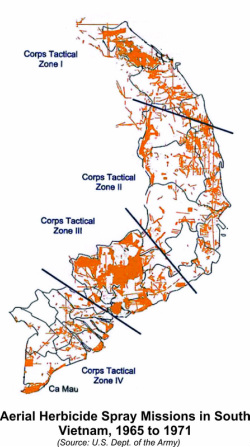Agent Orange
" . . . the Other Wound"

Agent Orange was a blend of herbicides used by the U.S. military, during the Vietnam conflict, to deny concealment to enemy forces and to destroy crops. More than 19 million gallons of herbicides were sprayed. The most common, Agent Orange, was sprayed in all four military zones of South Vietnam.
Heavily sprayed areas included the inland forests near the Demilitarized Zone; inland forests at the junction of the borders of Cambodia, Laos, and South Vietnam; inland forests north and northwest of Saigon; mangrove forests on the southernmost peninsula of Vietnam; and mangrove forests along major shipping channels southeast of Saigon.
The issue of Agent Orange’s toxic effects on Veterans, who served in Vietnam, has simmered for decades. Its insidious impact on those exposed to it has become increasingly apparent. That growing awareness has resulted in the Congress, the Department of Veterans Affairs, and the Institute of Medicine’s validation of diseases, which to date, have been granted presumption of service connection for those exposed to Agent Orange.
The Agent Orange Act of 1991, further authorized the Secretary of Veterans Affairs to obtain independent scientific review by the National Academy of Sciences of data and evidence in order to determine if there are any additional diseases caused by exposure to Agent Orange or other herbicides used in the Vietnam Conflict. Due to this Act, additional diseases may be added to the list of presumptive diseases warranting automatic coverage of disability benefits for certain Vietnam veterans.
This action means that Veterans who were exposed to herbicides in service and who suffer from one of the “presumed” illnesses do not have to prove an association between their medical problems and their military service. This action helps Veterans to overcome the evidentiary requirements that might otherwise make it difficult for them to establish such an association in order to qualify for healthcare and other benefits needed as a result of their diseases. The “Presumption” simplifies and accelerates the application process exposure.and ensures that Veterans will receive the benefits they deserve.
Veterans who served in the Republic of Vietnam, including its inland waterways, between January 9, 1962 and May 7, 1975, are presumed to have been exposed to herbicides. However, Blue Water Navy Veterans must have actually stepped foot on the land of Vietnam or served on its inland waterways at sometime between January 9, 1962 and May 7, 1975 to be presumed to have been exposed to herbicides when claiming service-connection for diseases related to Agent Orange
Secretary Eric K. Shinseki - “White House Blog”
The Herbicides Used in Vietnam
In the early years of WWII, a grant was provided by the National Research Council to develop a chemical to destroy rice crops in Japan (the major food source of the Japanese). 2,4-D and 2,4,5-T (Agent Orange) was the result. A discussion between President Roosevelt and White House Chief of Staff, Admiral William D. Leahy determined that this heinous chemical should not be used. Agent Orange was not used during WWII.
In 1961, however, President Kennedy signed two orders allowing Agent Orange to be used in Vietnam. One order to destroy crops, and another order to defoliate the jungle. [Note: These orders were signed prior to major U.S. intervention.]
Agent Orange & other herbicides used extensively thru 1970
(and thereafter until the end of the Vietnam War) |
|
|
| Description |
TCDD (Dioxin) Amounts |
| Agent Orange |
1.77 to 40 ppm |
| Agent Blue (Purple) |
32.8 to 45 ppm |
| Agent Red (Pink) |
65.6 ppm |
| Agent White (Green) |
65.6 ppm |
| Silvex |
1 to 70 ppm |
| 2,4,5-T (Current) |
0.1 ppm or less |
The Legacies of War - Agent Orange
 legacies_of_war-agent_orange-11-16-2012-1.pdf
legacies_of_war-agent_orange-11-16-2012-1.pdf
Download File
Veterans and Agent Orange: Update 2012
Report of the Committee to Review the Health Effects in Vietnam Veterans of Exposure to Herbicides (Ninth Biennial Update)
- Read on-line
Link: http://books.nap.edu/openbook.php?record_id=18395&page=R1